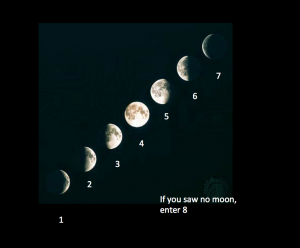These are the questions you will need to answer each time you log on to Blackboard to enter your results.
-
- How did you determine the direction of due west? (1st observation for weeks 1-3 only, 1 point)
-
- (a) Compass
-
- (b) GPS, smart phone, or other handheld device
-
- (c) Map
-
- (d) Other
-
- How did you determine the direction of due west? (1st observation for weeks 1-3 only, 1 point)
2. If you selected “Other” for #1, explain what method you used. If you did not choose “Other”, leave this blank.
3. What is the address or other specific description of your observation location? (Use the same location for all observations.) (1st observation for weeks 1-3 only, 1 point)
4. Enter the month of your observation date (1-12), and the day (1-31), each as a SINGLE NUMBER within the ranges noted. (2 parts together worth 1 point).
Example: Enter the month and day of an observation on Feb. 10 by entering “2” (with no quotes) then “10” NOT by entering “February 10, 2011” or similar text input.
5. Enter the hour of your observation time (1-12), and the minute (0-59), each as a SINGLE NUMBER within the ranges noted (any ranges entered into Bb itself will result in the first number of that range being used in grading). (2 parts together worth 1 point).
Example: Enter the hour and minute of an observation at 5:20 PM by entering “5” (with no quotes) then “20” NOT by entering “5:20 PM” or similar text input.
6. True or false: The Sun set N of due W. (1 point)
7. Enter number of degrees N or S of due W the sun set. (1 point)
8. True or false: The Moon was visible in the sky at the time I made my observation (yes or no)? (1 point)**
**WARNING
If you did not see the Moon at sunset, DO NOT say that you did! You may be docked 20 points on your final observing project grade for fabricating an observation. See the instruction web page.
9. View the Moon phases in this image:
Choose the phase, labeled 1-7, that best corresponds to the moon phase you OBSERVED. (2 points) If you saw no moon, choose 8.
10. Which of the following labels matches the phase you entered in the last question? (1 point)
-
- (a) full
-
- (b) waning gibbous
-
- (c) 3rd quarter
-
- (d) waning crescent
-
- (e) waxing crescent
-
- (f) 1st quarter
-
- (g) waxing gibbous
- (h) no moon
- 11. Which of the following positions in the sky best describes your observation of the Moon? (1 point)
-
- (a) close to the eastern horizon
-
- (b) in the eastern sky, between the horizon and overhead (the meridian)
-
- (c) overhead (on the meridian), or close to overhead (the meridian)
-
- (d) in the western sky, between the horizon and overhead (the meridian)
-
- (e) close to the western horizon
-
- (f) no moon

This work is licensed under a Creative Commons Attribution 4.0 International License.
